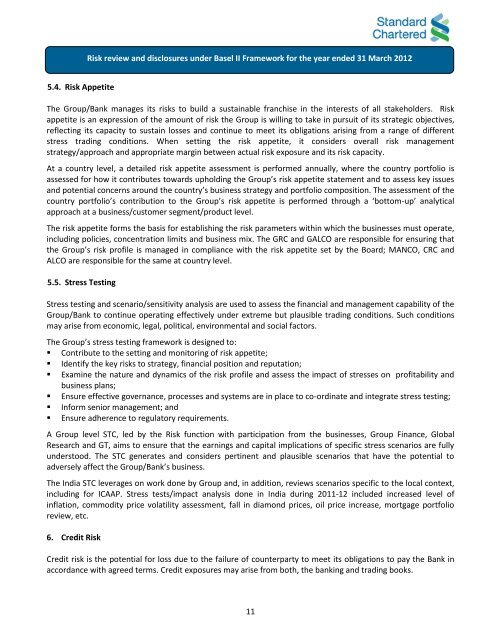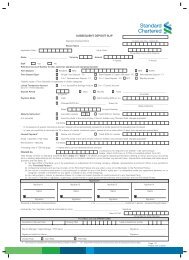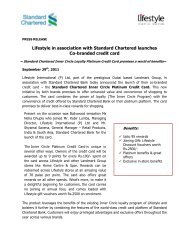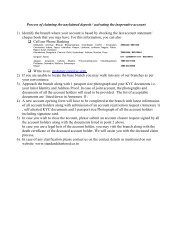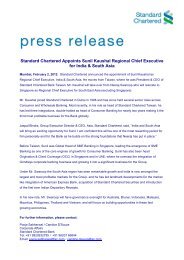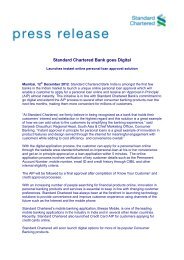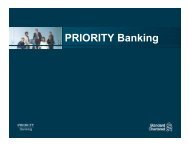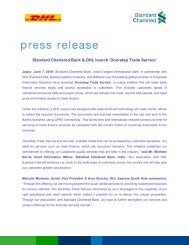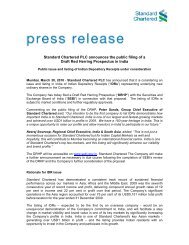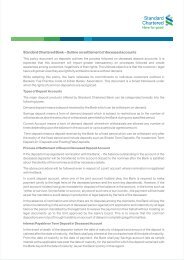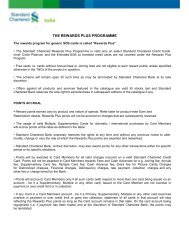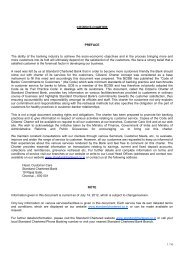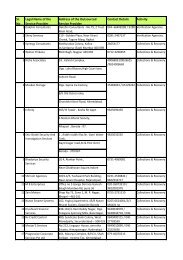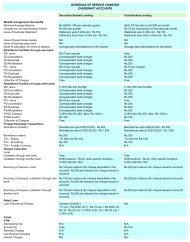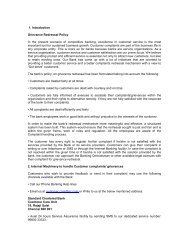March 12 - Standard Chartered Bank
March 12 - Standard Chartered Bank
March 12 - Standard Chartered Bank
Create successful ePaper yourself
Turn your PDF publications into a flip-book with our unique Google optimized e-Paper software.
Risk review and disclosures under Basel II Framework for the year ended 31 <strong>March</strong> 20<strong>12</strong><br />
5.4. Risk Appetite<br />
The Group/<strong>Bank</strong> manages its risks to build a sustainable franchise in the interests of all stakeholders. Risk<br />
appetite is an expression of the amount of risk the Group is willing to take in pursuit of its strategic objectives,<br />
reflecting its capacity to sustain losses and continue to meet its obligations arising from a range of different<br />
stress trading conditions. When setting the risk appetite, it considers overall risk management<br />
strategy/approach and appropriate margin between actual risk exposure and its risk capacity.<br />
At a country level, a detailed risk appetite assessment is performed annually, where the country portfolio is<br />
assessed for how it contributes towards upholding the Group’s risk appetite statement and to assess key issues<br />
and potential concerns around the country’s business strategy and portfolio composition. The assessment of the<br />
country portfolio’s contribution to the Group’s risk appetite is performed through a ‘bottom-up’ analytical<br />
approach at a business/customer segment/product level.<br />
The risk appetite forms the basis for establishing the risk parameters within which the businesses must operate,<br />
including policies, concentration limits and business mix. The GRC and GALCO are responsible for ensuring that<br />
the Group’s risk profile is managed in compliance with the risk appetite set by the Board; MANCO, CRC and<br />
ALCO are responsible for the same at country level.<br />
5.5. Stress Testing<br />
Stress testing and scenario/sensitivity analysis are used to assess the financial and management capability of the<br />
Group/<strong>Bank</strong> to continue operating effectively under extreme but plausible trading conditions. Such conditions<br />
may arise from economic, legal, political, environmental and social factors.<br />
The Group’s stress testing framework is designed to:<br />
• Contribute to the setting and monitoring of risk appetite;<br />
• Identify the key risks to strategy, financial position and reputation;<br />
• Examine the nature and dynamics of the risk profile and assess the impact of stresses on profitability and<br />
business plans;<br />
• Ensure effective governance, processes and systems are in place to co-ordinate and integrate stress testing;<br />
• Inform senior management; and<br />
• Ensure adherence to regulatory requirements.<br />
A Group level STC, led by the Risk function with participation from the businesses, Group Finance, Global<br />
Research and GT, aims to ensure that the earnings and capital implications of specific stress scenarios are fully<br />
understood. The STC generates and considers pertinent and plausible scenarios that have the potential to<br />
adversely affect the Group/<strong>Bank</strong>’s business.<br />
The India STC leverages on work done by Group and, in addition, reviews scenarios specific to the local context,<br />
including for ICAAP. Stress tests/impact analysis done in India during 2011-<strong>12</strong> included increased level of<br />
inflation, commodity price volatility assessment, fall in diamond prices, oil price increase, mortgage portfolio<br />
review, etc.<br />
6. Credit Risk<br />
Credit risk is the potential for loss due to the failure of counterparty to meet its obligations to pay the <strong>Bank</strong> in<br />
accordance with agreed terms. Credit exposures may arise from both, the banking and trading books.<br />
11


